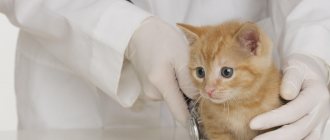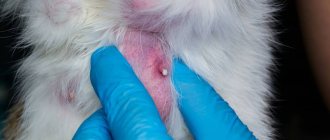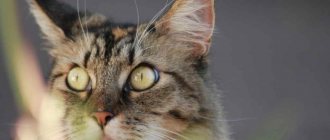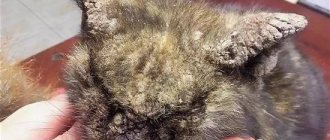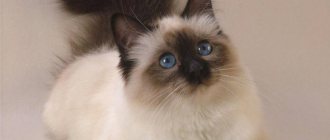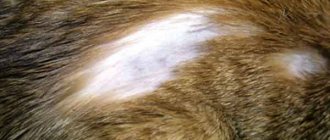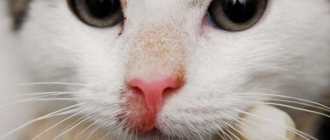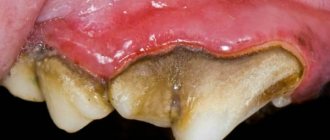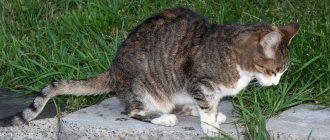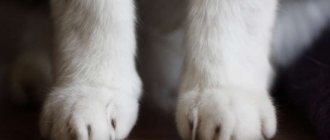What will you learn from the article?
- Causes of rickets in cats
- Symptoms
- Diagnostic methods
- Treatment Nutrition for rickets
A kitten is a child who is growing, and during this process he can develop various diseases. Rickets in kittens is a growing disease. Among ordinary people there is an opinion that this disease is caused by a lack of sunlight. In fact, rickets develops against the background of impaired metabolism and deficiency of vital vitamins and minerals.
If for some reason a growing body lacks vitamin D, calcium and phosphorus, malformations of the musculoskeletal and nervous systems occur. Due to a lack of microelements, the kitten’s skeleton develops incorrectly, it develops a rickets physique, and the pet lags behind its peers in development.
It is important to identify this disease as soon as possible, since the consequences of rickets can be irreversible. The disease, detected at an early stage, is treatable.
Causes of rickets
This pathology is of two types:
- The congenital type develops in kittens as a result of poor quality and unbalanced nutrition of their mother.
- The acquired form appears in those babies who are not well cared for. Often the disease develops against the background of long-term viral and chronic pathologies, diseases of the digestive organs, liver or kidneys.
The cause of the disease is also insufficient intake of vitamin D into the animal’s body, a lack of essential vitamins - phosphorus, magnesium, potassium, calcium.
A congenital disease can appear immediately after the birth of a kitten. It is provoked by:
- premature mating of the cat or her illness at this moment;
- exhaustion of the animal or the presence of genetic abnormalities;
- insufficient amount of taurine contained in the body of a pregnant female;
- lack of protein in the diet;
- mating with cats of related origin (usually many sick kittens are born in such a litter);
- frequent matings;
- lack of vitamins and minerals in a cat during pregnancy.
Factors that provoke the development of the acquired form of rickets in children:
- lack of sun and lack of fresh air;
- feeding with low-quality breast milk substitutes;
- early weaning from the mother and the same early transfer of the kitten to solid food;
- lack of vitamins and minerals in the feed;
- malabsorption of nutrients.
Photo of rickets in kittens
Ringworm in cats - main signs, symptoms, prevention and treatment of ringworm in cats (105 photos)Pancreatitis in cats: first symptoms, nutritional nuances and treatment options (125 photos and videos)
Subcutaneous mites in cats - first symptoms, treatment options and real photos of examples of parasite damage (110 photos + video)
Read here Constipation in cats: main causes, first symptoms, types of disease and treatment of constipation (110 photos)
Help the site, share with friends 
Is vitamin D always to blame?
Almost all owners are inclined to believe that rickets can develop solely due to a lack of vitamin D. To replenish it, they begin to give the animals fish oil in large quantities. In this case, the vitamin deficiency can actually be replenished (sometimes there is an excess of it in the body), but the disease remains. Moreover, it begins to imperceptibly undermine the baby’s health, sometimes remaining in his body throughout his life.
Rickets can also develop due to calcium deficiency. No matter how much vitamin D is supplied, bone tissue does not grow enough due to calcium deficiency. This is how the symptoms of rickets arise. If there is too much phosphorus in the blood, it begins to block the absorption of calcium, causing the body to suffer.
Main causes of hypovitaminosis D
In order to prevent dangerous metabolic disorders in furry young animals, you need to know what factors provoke them. As veterinary practice shows, these include:
- Incorrectly formulated diet for a pregnant cat mother. Lack of food or imbalance of proteins, essential amino acids, such as taurine, vitamins D, C, E, phosphorus, magnesium, calcium.
- Neglect of the rules of breeding cats: attracting an unformed female to mating; frequent matings, during which the body of a constantly giving birth cat is depleted; crossing of related animals; admission to mating of a weakened or obese partner.
- Violation by the owner of sanitary and hygienic standards for keeping kittens. To raise healthy offspring, sufficient humidity and good ventilation in the room are necessary. The baby should be outside during the daytime, since sunlight is the most important catalyst for metabolic processes in the body.
- Deviation from the requirements for feeding babies: inadequate complementary feeding of weaned kittens (mixtures from a dairy kitchen, cow's milk), a sharp transition to self-feeding, inadequate dry food with a lack of valuable additives - participants in metabolism.
- Gastrointestinal problems of a parasitic, infectious or enzymatic nature that prevent beneficial substances from being absorbed into the blood.
Symptoms of the disease
Typically, a breeder identifies rickets in a small kitten by the following signs:
- significant lag in growth and development compared to other kittens in the litter;
- lack of communication with his fellows, prefers to sit unnoticed in the corner;
- conditioned reactions are usually slowed down;
- the back of the animal sags, and the belly increases significantly;
- the spine and legs are noticeably curved;
- the gait is unsteady and uncertain, sometimes with a noticeable limp;
- no change of teeth is observed;
- joints are usually increased in size;
- the ribs are flattened.
Sometimes the animal develops diarrhea, muscle spasms, shortness of breath and a severe cough. These are secondary signs indicating the development of this pathology.
At what age does the disease appear?
Rickets can manifest itself between the ages of 2 weeks and up to six months. During this time, babies need to be examined daily. It is necessary to closely monitor the growth of kittens, since even a slight lag from normal indicators indicates the development of very severe pathologies. As the kitten gets older, the symptomatic picture becomes more pronounced and intense. It can be extremely difficult to control the disease in older age.
Consequences of rickets
Rickets is a dangerous lesion of bone tissue in the form of thinning and curvature. In addition, pathology causes disturbances and disorders in the functioning of all organs and systems. The consequences of the disease are:
- subsequent gradual curvature and irreversible thinning of the bones, as a result of which the cat remains disabled for life;
- chronic inflammation and destruction of cartilage and tissue;
- disruption of the liver and the entire gastrointestinal tract;
- reducing to a minimum the process of absorption of vitamins and microelements, causing the pet to lose a lot of weight and constantly get sick;
- development of severe convulsive seizures;
- development of oxygen starvation.
Further progression of these phenomena is associated with a high risk of death of the cat.
Features of the disease
What are the signs of rickets in kittens? It is recommended that you first familiarize yourself with the characteristics of this disease.
- Rickets is a pathological process in the area of bone tissue, which is accompanied by its softening and deformation.
- As a result, the animal's teeth deteriorate and the formation of the skeleton is disrupted.
- The disease poses a particular danger to joints. They are not able to support the weight of a cat.
- Gradually, the joint capsule becomes deformed, and the cartilage layer becomes thinner.
- The pet's growth is sharply reduced, and the spinal column takes on an irregular shape.
The slow rate of development is accompanied by a malfunction of the liver. Its tissues are unable to quickly cope with protein synthesis. Lack of normal levels of nutrients negatively affects the condition of the gallbladder.
The organ is not able to produce the normal composition of bile, which allows the absorption of fats and stimulate intestinal motility. As a result, problems arise with the animal's defecation. As a result, your pet will suffer from regular constipation or prolonged diarrhea.
- Insufficient fat levels are accompanied by depletion of the fat layer.
- Similar disorders are observed in the cardiovascular system.
- The heart begins to beat more slowly.
- A small kitten does not receive the proper level of oxygen, as a result of which it may die.
Diagnosis of the disease
The diagnosis of rickets cannot be made at home solely on the basis of examining the kitten and the presence of specific symptoms. Diagnostic measures are carried out exclusively in a veterinary clinic. The final diagnosis is made after an examination, which includes:
- Analysis of the conditions of keeping the animal, nutrition, developmental features in the prenatal period.
- Blood test for biochemical composition. It is necessary to determine the amount of calcium, phosphorus and vitamin D in the blood.
- Biochemical analysis of cat urine.
- X-ray examination of vertebral and bone tissues (to assess the degree of changes in the musculoskeletal system of the animal).
- Histological examination of bone tissue.
This disease must be differentiated from:
- false rickets;
- rheumatism;
- damage to the thyroid gland;
- osteomalacia.
Who is at risk
Rickets most often affects kittens born from stray street cats. Considering the harsh conditions of the surrounding world, poor diet, uncontrolled mating, expectant mothers are weakened, exhausted, and often suffer from systemic ailments, viral-bacterial, and parasitic infections.
If you decide to adopt a kitten from the street, be sure to show the little pet to the veterinarian. It is possible that, in addition to problems with the musculoskeletal system, the animal will be diagnosed with other health problems during examination.
Important! A weak litter, if the cat is not properly prepared before mating, is observed in representatives of large breeds (Maine Coons, Burmese, Scottish breeds).
As already noted, kittens kept on artificial feeding are also at risk. If you feed your pets regular cow's milk or low-quality formulas for infants, this will lead to disruption of the protein-lipid balance and metabolism, and will provoke rickets.
It is believed that kittens born in the fall are weaker and more often susceptible to rickets, which is explained not only by a lack of vitamins and minerals, but also by a lack of UV radiation (sunlight).
Treatment of rickets
This disease is easily cured, but only if the diagnosis is made early. Kitten owners should prepare for the fact that the therapy will be lengthy. In a stationary veterinary clinic, the following is carried out:
- intravenous administration of veterinary drugs to treat imbalances of vitamins and minerals;
- irradiation of the animal’s body using quartz lamps (ultraviolet source);
- prescribing enzyme preparations and medications to support the heart.
The main measures for treating feline rickets at home are as follows:
- administration of vitamin D in the form of a solution (sometimes fish oil is used for veterinary use);
- injections of the drug Tetravit (a multivitamin to strengthen the kitten’s body);
- exposure to the sun;
- massages.
Treatment is impossible without regulating the baby’s motor activity.
Prevention
- Be sure to bread the cat's mating - she should not have more than 2 pregnancies in 1 year, the female's diet should be high-calorie and completely balanced. Do not allow your pet to mate if she has infectious diseases, gastrointestinal diseases or obesity.
- Take the kitten away from the cat after at least 10 weeks to ensure full breastfeeding.
- Provide proper diet and proper care for your pet.
- Take your cat for walks in the fresh air. If the kitten is too small for vaccinations or is exclusively domestic, you can let it walk on an open loggia or in a sunny room with open windows.
- Be sure to get vaccinated and take prophylactic antihelminthic medications.
- Feeding with food with a good calcium content, preferably on the recommendation of a veterinarian.
- Prophylactic intake of fish oil or vitamin D is possible.
Calcium restoration
To restore this essential mineral you will need:
- give intravenous injections of calcium-containing drugs (done only by veterinarians in a clinic);
- correction of the kitten’s diet with the introduction of fermented milk products and fish (in no case river fish);
- choose a special type of food enriched with calcium and other minerals.
